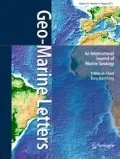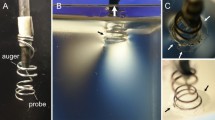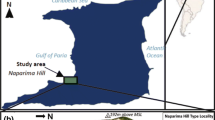Abstract
This paper describes a new, miniature, instrumented flat dilatometer (mIDMT) designed to assess variations in nearly continuous compressive stress–strain behaviour with depth in shallow cohesive sediments. The instrument was tested both in situ in the Bay of Fundy, Nova Scotia, Canada, and in cored samples from Willapa Bay, Washington, USA. Comparisons between probe and laboratory uniaxial assessments for other elastic materials—gelatine and foam rubber specifically—show strong agreement over the range of strains induced in the experiments. Observed values of Young’s modulus (E) for the gelatine and ethylene-vinyl acetate foam ranged from 6–343 kPa. Sediment stress–strain curves were distinctly linear for the overconsolidated fine-grained sediments of the Minas Basin, and values of E were found to increase with depth from near zero to 500–1,300 kPa at 20 cm depth. At the Willapa site, the sandy tidal flat sediments also behave elastically but E tended to increase more strongly with depth than for sediments from the Minas Basin. Young’s modulus was inversely correlated to porosity at all sites tested, and linearly related to shear strength in the Minas Basin. The newly designed instrument has much finer resolution than for other, similar methods of determining E in situ, and it provides data at a resolution sufficient to assess small-scale processes such as gas bubble growth and infaunal locomotion, for which elastic constants are needed for modelling and prediction.












Similar content being viewed by others
References
Akbar A, Clarke B (2001) A flat dilatometer to operate in glacial tills. Geotech Test J 24:51–60
Algar CK, Boudreau BP (2009) Transient growth of an isolated bubble in sediments. Geochim Cosmochim Acta 73:2581–2591
Algar CK, Boudreau BP, Barry MA (2011) Initial rise of bubbles in cohesive sediments by a process of viscoelastic fracture. J Geophys Res 116:B04207. doi:10.1029/2010JB008133
ASTM (2001) Standard test method for performing the flat plate dilatometer D6635. ASTM Intl, West Conshohocken, PA
Baligh MM, Azzouz AS, Chin C-T (1987) Disturbances due to “ideal” tube sampling. J Geotech Eng 113:739–757
Barry MA, Boudreau BP, Johnson BD, Reed A (2010) First-order description of the mechanical fracture behavior of finegrained surficial marine sediments during gas bubble growth. J Geophys Res 115:F04029. doi:10.1029/2010JF001833
Benoit J, Stetson KP (2003) Use of an instrumented flat dilatometer in soft varved clay. J Geotech Geoenviron Eng 129:1159–1167
Boudreau BP (1994) Is burial velocity a master parameter for bioturbation? Geochim Cosmochim Acta 58:1243–1249
Boudreau BP, Algar C, Johnson BD, Croudace I, Reed A, Furukawa Y, Dorgan KM, Jumars PA, Grader AS, Gardiner BS (2005) Bubble growth and rise in sediments. Geology 33:517–520
Clayton CRI, Heymann G (2001) Stiffness of geomaterials at very small strains. Geotechnique 51:245–255
Daborn GR, Brylinsky M, van Proosdij D (2003) Ecological studies of the Windsor causeway and Pesaquid Lake, 2002. Wolfville, Nova Scotia, Publ no, Acadia Centre for Estuarine Research, 69
Dorgan KM, Jumars PA, Johnson BD, Boudreau BP, Landis E (2005) Burrow extension by crack propagation. Nature 433:475
Griffith AA (1921) The phenomena of rupture and flow in solids. Philos Trans R Soc Lond A 221:163–198
Johnson BD, Boudreau BP, Gardiner B, Maass R (2002) Mechanical response of sediments to bubble growth. Mar Geol 187:347–363
Johnson BD, Barry MA, Boudreau BP, Jumars PA, Dorgan KM (2012) In situ tensile fracture toughness of surficial cohesive marine sediments. Geo-Mar Lett 32(1):39–48. doi:10.1007/s00367-011-0243-1
L’Esperance JC (2009) Simultaneous measurements of Young’s modulus and Poisson’s ratio of marine sediments with a simple uni-axial compression test. Dalhousie University, MSc Thesis
Marchetti S (1980) In situ tests by flat dilatometer. J Geotech Eng Division, ASCE, 106(GT3). Proc Pap 15290:299–321
Robertson PK (2009) Interpretation of cone penetration tests – a unified approach. Can Geotech J 46:1337–1355
Sneddon IN (1946) The distribution of stress in the neighbourhood of a crack in an elastic solid. Proc R Soc Lond A 187(1009):229–260
Stalebrass SE, Atkinson JH, Masin D (2007) Manufacture of samples of overconsolidated clay by laboratory sedimentation. Geotechnique 57:249–253
Stetson KP, Benoit J, Carter MJ (2003) Design of an instrumented flat dilatometer. Geotech Test J 26:1–8
Tolhurst TJ, Riethmüller R, Paterson DM (2000) In situ versus laboratory analysis of sediment stability from intertidal mudflats. Cont Shelf Res 20:1317–1334
Wheatcroft RA (2002) In situ measurements of near-surface porosity in shallow-water marine sands. IEEE J Oceanic Eng 27(3):561–570
Winterwerp JC, van Kesteren WGM (2004) Introduction to the physics of cohesive sediment in the marine environment. Elsevier, Amsterdam
Acknowledgements
This research was funded by the US Office of Naval Research through grants N00014-08-0818 and N00014-05-1-0175 (project managers J. Eckman and T. Drake) and by the Natural Sciences and Engineering Council of Canada. We would like to thank Brent Law, Paul Hill, Tim Milligan and others from the Willapa working group for help with the collection of cores and grain size analysis. We also thank three anonymous reviewers for their comments.
Author information
Authors and Affiliations
Corresponding author
Electronic supplementary material
Below is the link to the electronic supplementary material.
Electronic supplementary material: video showing penetration of the mIDMT into a soft modelling compound. Some shearing occurs at the probe surface, visible as downward bending of layers near the mIDMT. Scale: light-coloured layers are 1.3 cm thick (MP4 2186 kb)
Electronic supplementary material: video showing penetration of an object equivalent in dimensions to a DMT into a soft modelling compound. Shearing occurs at the probe surface, visible as downward bending of layers near the object, and the large lateral displacements cause upward bending of layers at roughly 2 cm from the surface of the probe. Scale: light-coloured layers are 1.3 cm thick (MP4 1166 kb)
Rights and permissions
About this article
Cite this article
Barry, M.A., Johnson, B.D. & Boudreau, B.P. A new instrument for high-resolution in situ assessment of Young’s modulus in shallow cohesive sediments. Geo-Mar Lett 32, 349–357 (2012). https://doi.org/10.1007/s00367-012-0277-z
Received:
Accepted:
Published:
Issue Date:
DOI: https://doi.org/10.1007/s00367-012-0277-z




